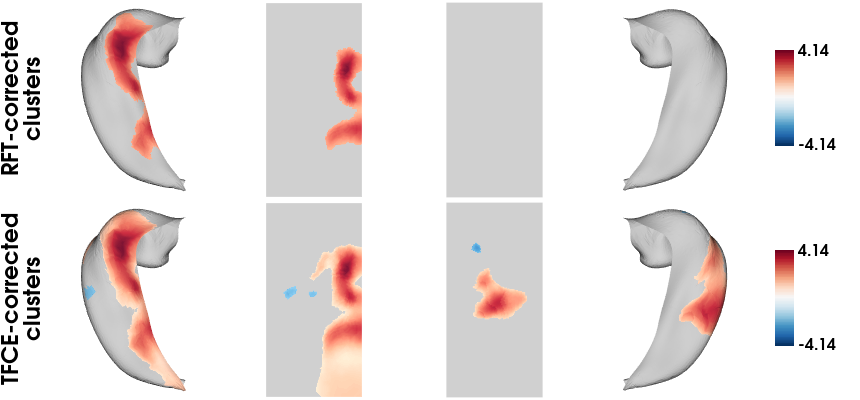
Example analyses with VertexWiseR - Example 2
Charly Billaud, Junhong Yu
2025-07-16
VertexWiseR_Example_2.RmdExample 2: Mixed effect model of intervention-related changes on hippocampal thickness
Note: This is the most up-to-date demo. Its version published in Imaging Neuroscience (2024) 2: 1–14 no longer applies since the v1.3.0 fixes made to the TFCE_vertex_analysis_mixed() function (see our updates page for details).
The analysis will use surface data already extracted in R from a preprocessed subjects directory, which we make available so you do not need to preprocess a sample yourself. To obtain it, we had extracted cortical thickness (CT) data from a Hippunfold preprocessing directory of the Fink dataset (Fink et al. 2021).
The demo data (218 MB) required to run the package demos can be downloaded from the package’s github repository with the following function:
#This will save the demo_data directory in a temporary directory (tempdir(), but you can change it to your own path)
demodata=VertexWiseR:::dl_demo(path=tempdir(), quiet=TRUE)Here is the command line which was originally used to extract the surface:
#HIPvextract(sdirpath = hippunfold_SUBJECTS_DIR, filename = "FINK_Tv", measure = "thickness", subj_ID = T)To load the hippocampal thickness matrix:
To smooth the surface data:
FINK_Tv_smoothed_ses13 = smooth_surf(FINK_Tv_ses13, 5)To load the behavioural data (FINK_behdata_ses13.csv, which contains two rows per participant, for scanning sessions 1 and 3).
Here, we are interested in the interaction between session number (time) and group. To run the vertex-wise mixed model analysis with random field theory-based cluster correction, testing for the effect of session, group, session * group interaction, on hippocampal thickness, with subject ID as a random variable:
model2_RFT=RFT_vertex_analysis(
model = dat_beh_ses13[,c("session","group","session_x_group")],
contrast = dat_beh_ses13[,"session_x_group"],
surf_data=FINK_Tv_smoothed_ses13,
random=dat_beh_ses13[,"participant_id"], p=0.05)
model2_RFT$cluster_level_results## $`Positive contrast`
## clusid nverts P X Y Z tstat region
## 1 1 974 0.041 -13.3 27.5 1.3 4.14 L Subiculum
##
## $`Negative contrast`
## [1] "No significant clusters"To run the vertex-wise mixed model analysis with threshold-free cluster enhancement-based cluster correction, with 1000 permutations, testing for the effect of session, group, session * group interaction, on hippocampal thickness, with subject ID as a random variable:
set.seed(123)
model2_TFCE=TFCE_vertex_analysis_mixed(
model = dat_beh_ses13[,c("session","group","session_x_group")],
contrast = dat_beh_ses13[,"session_x_group"],
surf_data= FINK_Tv_smoothed_ses13,
nperm=1000,
random = dat_beh_ses13[,"participant_id"],
perm_type="within_between",
nthread=1)
TFCEoutput = TFCE_threshold(model2_TFCE, p=0.05)
TFCEoutput$cluster_level_results## $`Positive contrast`
## clusid nverts P X Y Z tstat region
## 1 1 73 0.033 -27.5 27.5 1.3 4.14 L Subiculum
##
## $`Negative contrasts`
## [1] "No significant clusters"To plot the significant clusters from both models on the CITI168 hippocampal template surface:
tmaps = rbind(model2_RFT$thresholded_tstat_map, TFCEoutput$thresholded_tstat_map)
plot_surf(surf_data = tmaps,
filename = 'FINK_tstatmaps.png',
title=c('RFT-corrected\nclusters','TFCE-corrected\nclusters'),
cmap='Reds',
show.plot.window=FALSE)
Example 2 follow-up: plotting and post-hoc analyses of hippocampal clusters across regression models
The code below was used in R (v.4.3.3) to plot the cluster-wise values from the RFT and TFCE corrected analyses and validate them with additional mixed linear models.
We produce a figure displaying the thickness of the hippocampal clusters in relation to the group and session variables, in RFT and TFCE models, demonstrating a steeper curve toward group 2:
#We divide the cluster values by their sum to get the average thickness per vertex
dat_beh_ses13$clustCTTFCE=(FINK_Tv_smoothed_ses13 %*% TFCEoutput$pos_mask)/sum(TFCEoutput$pos_mask>0)
dat_beh_ses13$clustRFT=(FINK_Tv_smoothed_ses13 %*% model2_RFT$pos_mask)/sum(model2_RFT$pos_mask>0)
library(ggplot2)
library(ggbeeswarm)
library(cowplot)
a=ggplot(data=dat_beh_ses13,aes(y=clustCTTFCE,x=as.factor(session), color=as.factor(group)))+
geom_quasirandom(dodge.width=0.5)+
geom_line(aes(group=participant_id), alpha=0.2)+
geom_smooth(aes(group=group), method="lm")+
labs(y="Mean thickness (mm)", x="session", color="group")+
guides(colour = "none")+
ggtitle("Positive cluster\n (TFCE-corrected)")+
ylim(1.1, 1.55)
b=ggplot(data=dat_beh_ses13,aes(y=clustRFT,x=as.factor(session), color=as.factor(group)))+
geom_quasirandom(dodge.width=0.5)+
geom_line(aes(group=participant_id), alpha=0.2)+
geom_smooth(aes(group=group), method="lm")+
labs(y="Mean thickness (mm)", x="session", color="group")+
ggtitle("Positive cluster\n(RFT-corrected)")+
scale_color_discrete(name="Group",labels=c("group 1", "group 2"))+
ylim(1.1, 1.55)
png(filename="traj.png", res=250, width=1400,height=604)
plots=plot_grid(a,b, nrow=1,rel_widths=c(0.3,0.40))
print(plots)
dev.off()
As an additional validation of these results, these significant clusters were extracted as regions-of-interests and fitted in a linear mixed effects model using another R package— lmerTest (Kuznetsova, Brockhoff, and Christensen 2017).
Linear mixed effect testing the effect of session, group, and session * group interaction on the positive RFT clusters’ average thickness value
lme.RFT=lmer(clustRFT~session+group+session*group+(1|participant_id),data =dat_beh_ses13 )
summary(lme.RFT)## Linear mixed model fit by REML. t-tests use Satterthwaite's method [
## lmerModLmerTest]
## Formula: clustRFT ~ session + group + session * group + (1 | participant_id)
## Data: dat_beh_ses13
##
## REML criterion at convergence: -317.1
##
## Scaled residuals:
## Min 1Q Median 3Q Max
## -2.69862 -0.43221 -0.04002 0.42291 2.57082
##
## Random effects:
## Groups Name Variance Std.Dev.
## participant_id (Intercept) 0.004837 0.06955
## Residual 0.000236 0.01536
## Number of obs: 96, groups: participant_id, 48
##
## Fixed effects:
## Estimate Std. Error df t value Pr(>|t|)
## (Intercept) 1.326760 0.010717 54.685962 123.801 < 2e-16 ***
## session -0.003450 0.001580 46.000000 -2.183 0.0342 *
## group -0.006877 0.010717 54.685962 -0.642 0.5237
## session:group 0.007645 0.001580 46.000000 4.837 1.51e-05 ***
## ---
## Signif. codes: 0 '***' 0.001 '**' 0.01 '*' 0.05 '.' 0.1 ' ' 1
##
## Correlation of Fixed Effects:
## (Intr) sessin group
## session -0.295
## group -0.125 0.037
## session:grp 0.037 -0.125 -0.295Linear mixed effect testing the effect of session, group, and session * group interaction on the positive TFCE clusters’ average thickness value
lme.posTFCE=lmer(clustCTTFCE~session+group+session*group+(1|participant_id),data =dat_beh_ses13 )
summary(lme.posTFCE)## Linear mixed model fit by REML. t-tests use Satterthwaite's method [
## lmerModLmerTest]
## Formula: clustCTTFCE ~ session + group + session * group + (1 | participant_id)
## Data: dat_beh_ses13
##
## REML criterion at convergence: -272.9
##
## Scaled residuals:
## Min 1Q Median 3Q Max
## -1.50112 -0.45415 -0.05631 0.49916 1.71410
##
## Random effects:
## Groups Name Variance Std.Dev.
## participant_id (Intercept) 0.0048047 0.06932
## Residual 0.0005989 0.02447
## Number of obs: 96, groups: participant_id, 48
##
## Fixed effects:
## Estimate Std. Error df t value Pr(>|t|)
## (Intercept) 1.134943 0.011549 66.462361 98.275 < 2e-16 ***
## session -0.003589 0.002517 46.000000 -1.426 0.160692
## group -0.009920 0.011549 66.462361 -0.859 0.393452
## session:group 0.010234 0.002517 46.000000 4.065 0.000186 ***
## ---
## Signif. codes: 0 '***' 0.001 '**' 0.01 '*' 0.05 '.' 0.1 ' ' 1
##
## Correlation of Fixed Effects:
## (Intr) sessin group
## session -0.436
## group -0.125 0.054
## session:grp 0.054 -0.125 -0.436